

8m Stirling engine powered replica 19th century gentleman’s Great Lakes fantail launch
This project started when I happened on an antiques garage sale in Alameda, San Francisco in 2005 and recognised a propellor from a small steamboat. It was identifiable by its patina and by its aspect ratio (biggish diameter with two narrow blades), made this way for efficiency- to get the most from a low power engine. This is exactly what’s needed for a Stirling powered launch. Having the sudden thought that I could build such a craft, I bought it ($30 I recall) and did.
The next step took until 2008, when Nop and Michele Velthuizen, long-time friends from Holland, (who have made their home a home away from home for me since the ‘80’s), had the opportunity to spend a few months in NZ as our guests for a change.
Nop and I plotted a special project for while they were here- just so as he didn’t have to spend all his time ogling whales, dolphins, kiwis, mountains and lakes (him being a workshop kind of guy- and very proficient at making strip planked kayaks and the like.).
While here, Nop made an 8m fantail hull with the distinctive bow shape developed to handle occasional floating ice in the Great Lakes to be powered by a Stirling engine (my job). It’s made by the strip planking method, not 19th century woodworking; the strength and waterproofing being in the fibreglass/epoxy resin laminate on each side of a wood core, rather than relying on the wood as the main structural and sealing element.
However, the fibreglass surfacing is invisible (clear), and the resulting hull is light weight, strong, and no moulds were required, just 10 or so disposable frames. For Piwakawaka, Nop used 40mm x 6mm strips of poplar (with other woods to provide visual contrast) bent over frames and held together by common old pva glue. Shaping and tapering were required to make everything fit- but nothing tricky. With the hull form completely strip planked, the outer surface was faired with an orbital sander and a layer (or two where extra strength is required) of epoxy impregnated fibreglass cloth applied. After this had hardened, the frames were removed and the inner surface similarly faired and glassed. Piwakawaka was made in two halves- hull and then deck, these being joined later. Total making time was 30 days, plus extra for fitting the propeller and engine. Material costs; somewhat less than NZ $2000 (2008).
My part, the engine, was not ready for the hull however- because I’d had no time, being so often overseas at kite events. I also wasn’t rushing it because I fully anticipated that it wasn’t going to be easy. As every 19th century effort attests, getting useful power out of an unpressurised Stirling engine is not simply a matter of scaling up a successful model. Model Stirling engines are easy because their small size makes their heat transfer area to swept volume ratio advantageous, and because they don’t have to do more than overcome their own friction.
I did at that time have Stirling engines that would have worked for Piwakawaka, like a Whispergen (700 watt 4 cylinder wobble yoke alpha) and a converted Philips 95-15 cryocooler (single cylinder beta). But these are enclosed pressurised engines (20 bar nitrogen and 40 bar helium respectively) with all the interesting bits hidden away. This project just begged for an open crank design with externally visible cranks and levers. Plus, an early intention was to make it wood fired- so that mountain lakes and interesting coastlines could be explored using driftwood.
To get Piwakawaka on the water immediately, I borrowed a restored 1.5hp Stuart Turner “gentleman’s launch engine” from a fellow engine enthusiast. It was in excellent condition, showroom or better- but had not been run post-restoration. Hours of fruitless cranking failed to arouse more than the occasional pop- even after disassembling the carb and magneto and trying every other known trick. On taking it apart, it didn’t take long to see what the problem was- the restorer had failed to cut ports in the cylinder-to-crank-case gasket- a rather fundamental impediment for a 2 stroke IC engine. No fuel air mixture had been getting to the cylinder excepting what we’d squirted in via the spark plug hole for priming.
This fixed, the engine was a delight- started first turn, never stalled nor misbehaved. I can see why this model remained in production for nearly 50 years.
Our guess of gearing the motor to the propeller 2/1 was spot-on- 4knots+ with 4 passengers from just 1.5 hp- and not even working hard- though they were big horses I reckon.
It became obvious that this hull form is very easily driven- funny that, I guess they knew a thing or two back then when they didn’t have much horsepower to spare.
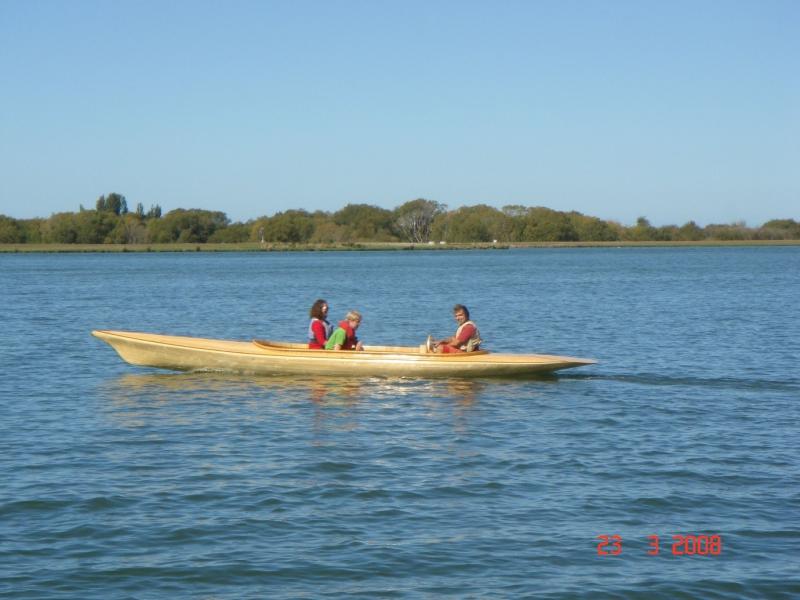
It then took 2 more years before I could complete a Stirling engine for Piwakawaka: LSM 11.1, 2008 (see LSM section for a more complete description). It’s fired by wood or books (especially Mills and Boons, which are un-clayed paper, conveniently sized and dumped by the tonne after book fairs here), but at around 200watts, doesn’t have quite enough oomph so was never installed. 11.1 was re-built with more robust linkages (11.2) and ran a yard cart (very slowly) in our 2009 “great Race” before being retired to a ceremonial role.
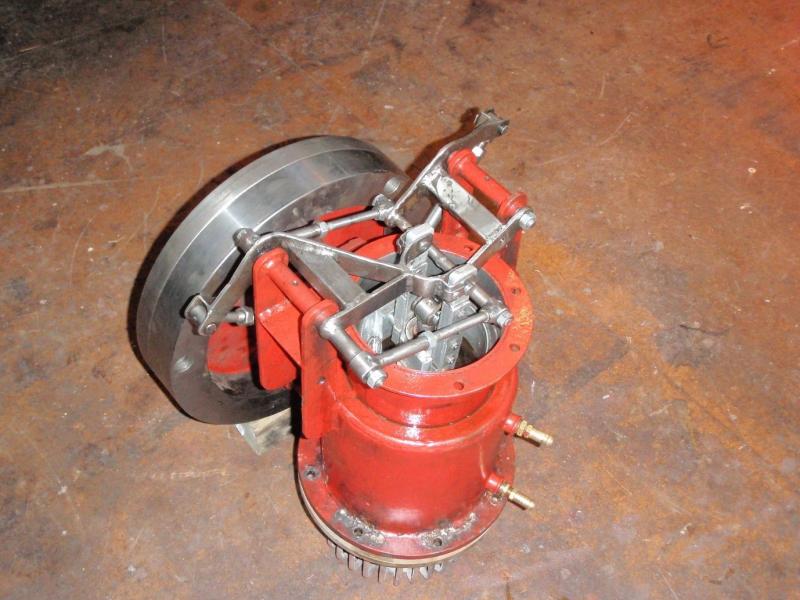
The next attempt, LSM 12.2, later in 2011, was successful (see development history in LSM series section). It was gas fired, developed around 300watts which was adequate though rather challenged when against waves and wind. It was used in Piwakawaka through to 2012, installed off-centre with the flywheel forward (which did provide better access to the rear than the later LSM 14.1 installation). By then the steering wheel had been moved forward and seating positions changed for better balance.
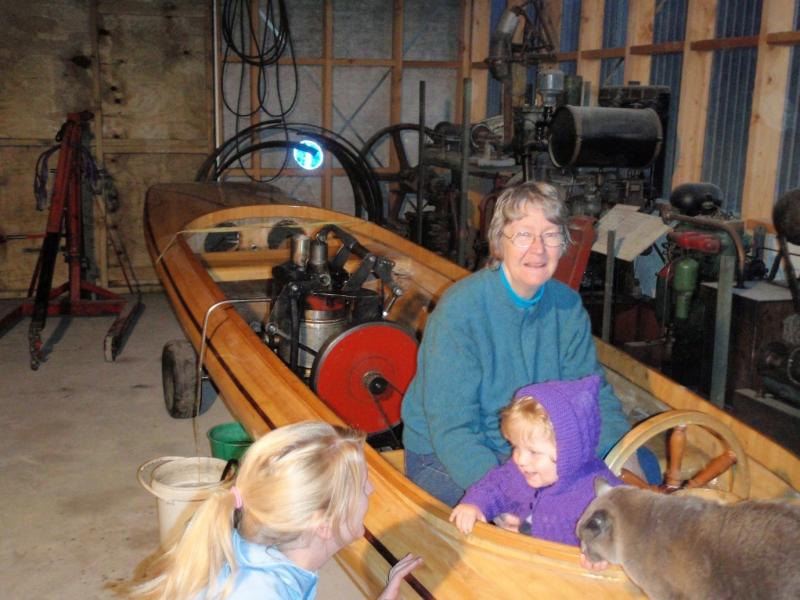
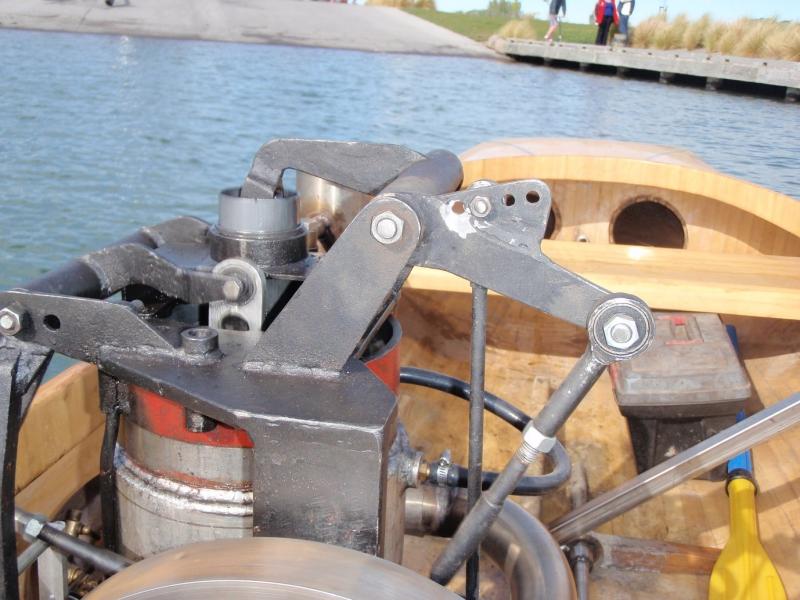
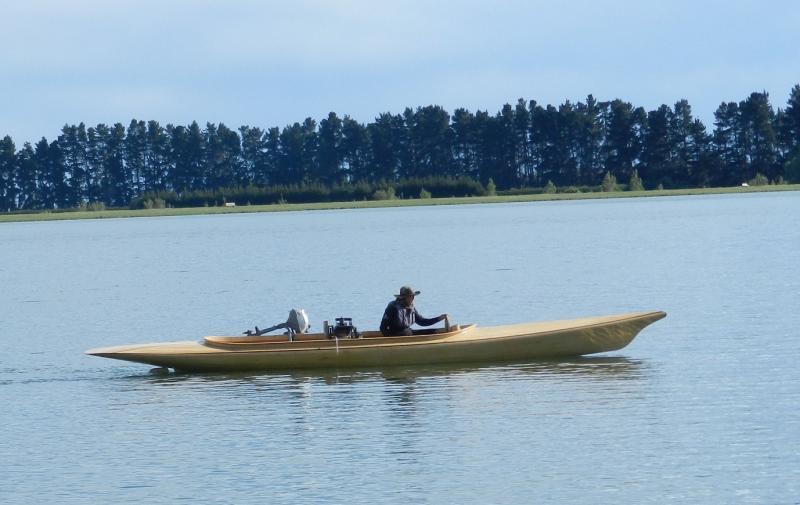
In 2012, LSM 12.2 was replaced by LSM 14.1 which has more power (approx. 400 watts) and has been completely satisfactory, with 100’s of hours running at Lake Hood (mainly), classic boat events and even on the sea at times. 12.2 was later improved (l2.3) to equal 14.1’s output and fitted in a motorcycle- and more lately, a mobility scooter..
Initially the LSM 14.1 engine used a ring type barbecue burner. This was quiet but difficult to get enough heating from. It was overly sensitive to where the gas tap was set- a fraction too open and it would flame out, burning only in the chimney. Not open enough and the boat was too slow. Combustion was also sensitive to wind direction.
From 2014, 14.1was fitted with a double venturi burner that is wind resistant and provides plenty of heating- but is noisy.
From cold it will move off within 1 minute of lighting the burner and pulls 300rpm (4.9knots) and sometimes even 320rpm.
To prevent the gas cylinder freezing up when gas draw is too high, the 9 kg gas cylinder (does a full day’s cruising) is in a water tank through which the engine’s cooling water passes before being returned to the lake.
Weed is a problem at Lake Hood (and sometimes on the sea) for which a mechanical weed wiper has been fitted. It can be operated from the rear seat.
Piwakawaka lacks a reverse gear, which can be a nuisance around docks. One could be easily fitted by adding a friction wheel to the engine flywheel which would run against a section of the propellor shaft pulley when the belt clutch is fully disengaged.
The only reliability issues so far (2025) have been in 2020 when the flywheel slipped on the engine shaft when starting and in 2022 when the displacer buckled. Both these were when passengers took an interminable time to embark, and the engine overheated before starting. A probable cause for the displacer buckling is that the displacer’s pressure equalising venting hole had blocked. Stirling engine displacers need to have a tiny vent hole to prevent their internal pressure becoming too high or low relative to the working space. If too large, such vent holes cause pumping losses.
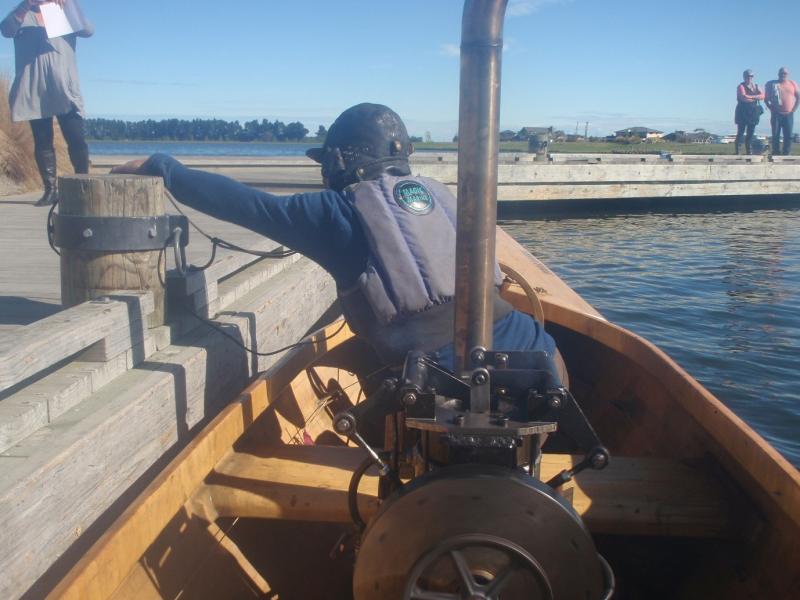
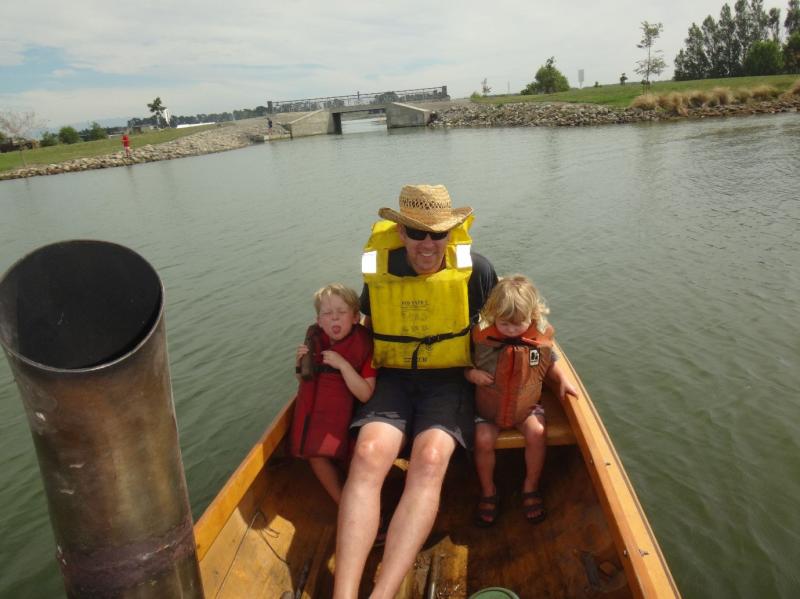
For those not from New Zealand, Piwakawaka is the local name for a cheeky little bird called the Fantail- an appropriate name for a fantail launch. Waka, coincidentally, is ‘boat’- hence its full description should be Piwakawaka waka.
Making another one, what would I change?
The hull: I’d go to a near vertical bow to increase the waterline length and make it even more easily driven.
The engine: I’d put effort into making the displacer lighter and fit it with more baffles. I’d also try to develop a gas burner that is quieter while still providing enough heat. Maybe I’d make it dual fuel at the same time- using driftwood still seems like a great idea.
And I’d definitely fit a reverse.
Peter Lynn, Ashburton NZ, to June 2025